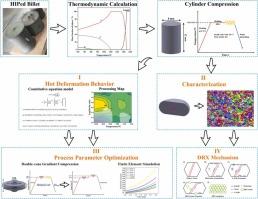FGH4096 PM高温合金工艺参数优化及组织演变
IF 6.3
2区 材料科学
Q2 CHEMISTRY, PHYSICAL
引用次数: 0
摘要
本文系统地研究了热等静压(HIPed) FGH4096粉末冶金(PM)高温合金的工艺参数优化和显微组织演变。参数优化方面,在传统本构方程和热工作图的基础上,创新性地增加了双锥压缩+热处理和夹杂物模拟,进一步优化了工艺参数。针对组织的演变,全面研究了热变形参数的影响和再结晶机理。此外,还阐明了PPBs和γ′相的演变,以及γ′相对再结晶的作用。优化后的温度范围为1070~1100℃,应变速率为1~10 s-1,应变小于1.8。PPB网络可以有效地突破高温和高应变速率。在热处理过程中,γ′相表现出双重功能:粗γ′(~1 μm)促进DRX,细γ′(100~300 nm)抑制DRX。HIPed FGH4096热变形过程中,DDRX是主导DRX机制,CDRX是辅助DRX机制,孪晶对DRX也有促进作用。本研究结果为优化FGH4096的热处理工艺,从而提高其组织均匀性和力学性能提供了有价值的指导。本文章由计算机程序翻译,如有差异,请以英文原文为准。

Optimization of process parameters and microstructure evolution of FGH4096 PM superalloy
In this study, the optimization of process parameters and the microstructure evolution of hot isostatically pressed (HIPed) FGH4096 powder metallurgy (PM) superalloy were systematically investigated. For parameter optimization, on the basis of the traditional constitutive equation and thermal working diagram, double-cone compression + heat treatment and inclusion simulation were innovatively added to further optimize the processing parameters. For the evolution of the tissue, the influence of thermal deformation parameters and the recrystallization mechanism were comprehensively studied. In addition, the evolution of PPBs and the γ′ phase, as well as the role of γ′ relative recrystallization, have also been clarified. The optimized parameters are a temperature range of 1070–1100 ℃, a strain rate of 1–10 s−1, and a strain below 1.8. The PPB networks can be effectively broken through high temperature and high strain rate. γ′ phase exhibited dual functionality during thermomechanical processing:Coarse γ′ (~1 μm) promoted DRX and fine γ' (100–300 nm) suppressed DRX. During the hot deformation process of HIPed FGH4096, DDRX is the dominant DRX mechanism, CDRX serves as an auxiliary DRX mechanism, and twins also promote DRX. The findings of this study provide valuable guidance for optimizing the thermal processing of FGH4096, thereby enhancing microstructural uniformity and mechanical performance.
求助全文
通过发布文献求助,成功后即可免费获取论文全文。
去求助
来源期刊

Journal of Alloys and Compounds
工程技术-材料科学:综合
CiteScore
11.10
自引率
14.50%
发文量
5146
审稿时长
67 days
期刊介绍:
The Journal of Alloys and Compounds is intended to serve as an international medium for the publication of work on solid materials comprising compounds as well as alloys. Its great strength lies in the diversity of discipline which it encompasses, drawing together results from materials science, solid-state chemistry and physics.
 求助内容:
求助内容: 应助结果提醒方式:
应助结果提醒方式:


